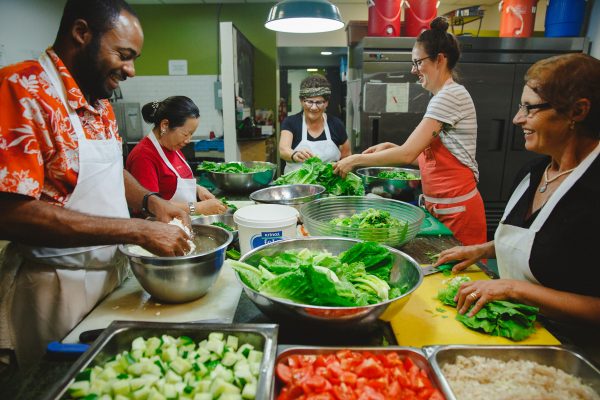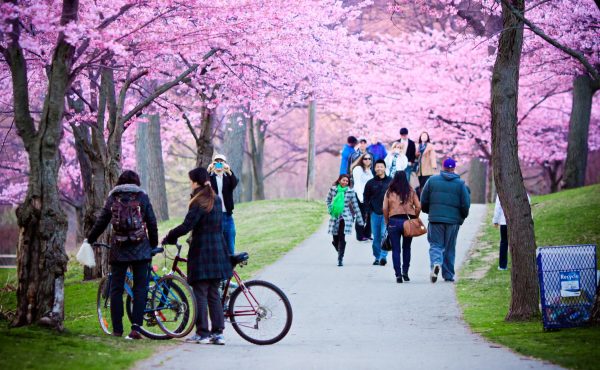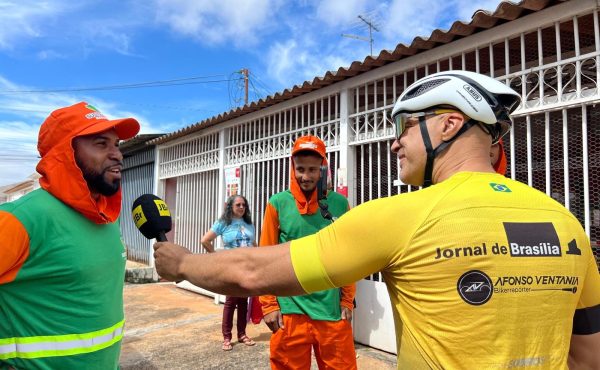The ability to feed our communities as a result of COVID-19 has the potential to increase awareness of the economic, social and environmental challenges that continue to challenge our cities’ resiliency.
Confined to our homes, we imagine a future city transformed by COVID-19. How much wider can we make our sidewalks? How can office environments safely accommodate workers? What will be the future of retail? Meanwhile, plenty of speculation continues about what restaurants will survive and what the food industry will look like when life slowly returns to normal. But however wide the sidewalks become to accommodate more patio seating, this pandemic has triggered a greater awareness about the need to embed food security into planning resilient cities. Flooding, earthquakes and other threats exacerbated by climate change crisis are being assessed by scientists, architects and urban planners alike to increase the “resiliency” of urban life but crises like our current pandemic are increasing the significance of food security and connecting us to issues like food supply, affordability and environmental stewardship.
In addition to grocery stores, restaurants and Instagrammable banana bread, food defines our communities through farmers markets and organizations that educate and engage us with concepts of environmental stewardship and agriculture. From the position of social inclusion, where there is often a lack of food, poverty and isolation can be seen. If we can then look at the design of our cities through the lens of food, then our awareness opens up to include food banks, community gardens and public parks. Food-related issues are suddenly more embedded into urban planning considerations than we thought.
Education, training and support in our communities is one clear path to heighten the significance of food. At the grassroots level, Grow Food Toronto is a group comprised of volunteers working at increasing education and awareness through urban agriculture, specifically targeting those who are most impacted, vulnerable or otherwise affected by this pandemic. Lorraine Johnson, a “cultivation activist” and one of the group’s organizers, describes her work as “digging deep into the fertile soils of our communities and grow good things.” Here is a powerful mission that builds independence and resiliency, especially important during a time where both unemployment and food prices are rising. Globally recognized for their training programs, certifications and workshops, Second Harvest is a food rescue organization that recovers food before it becomes waste and then redistributes it through a network of social service organizations, provides training on food production and preparation that can lead to new employment opportunities.
Knowledge is certainly an important part of food security: organizations are quick to note the number one reason why people call the City’s 2-1-1 information line is to find out how those with little or no money can access food.
Ryan Noble, Executive Director of North York Harvest Food Bank, emphasizes that COVID-19 has only intensified a pre-existing food crisis. 10,000 people visited his North York location in April. Before the pandemic, the network of 37 agencies operating food banks across the GTA saw over 16,000 children, women and men access food banks every month. With the onset of COVID-19, many low-capacity agencies in the inner suburbs immediately lost their ability to distribute food to community members because they operated out of places like community centres or places of worship. This led Noble and other food banks to partner with the Toronto Public Library, where currently 11 of their facilities serve as interim food distribution centres on a rotating basis. It’s been a good fit, as libraries are non-stigmatizing spaces: welcoming, clean and accessible. But this doesn’t necessarily mean that food banks should become a permanent design feature in libraries.
Noble welcomes the idea of food banks operating in de-stigmatized environments but makes it clear that most people will do anything in their power to not visit a food bank. “Once they’re reaching out to us for help,” he notes, “they’ve capitulated.” Organization like North York Harvest distribute food, but their real goal is to be an advocate against poverty. This remains their greatest challenge where over two-thirds of their client base derives income from social assistance.
Other food-related charities prioritize their visibility in the community quite differently. One example is The Stop Community Food Centre, which remains a vital part of daily life within the neighbourhood surrounding Wychwood Barns and along Davenport Road by increasing access to healthy food that builds dignity and a sense of community through an inclusive approach.
On March 16th, Leigh Godbold became its new Executive Director just as the lockdown swept across Toronto. Although she has been a volunteer and staff member since 2011, her experiences thus far have been trial by fire as the whole organization shifted toward emergency food delivery. With an average of 50 staff, 350 volunteers and over 18,000 people served every year, only 10 percent of The Stop’s budget comes from government support. To help fund its activities, The Stop holds four annual fundraising events, the largest being its popular Night Market normally held in June which attracts over 3,000 attendees.
Before Covid-19, those visiting The Stop would come in to have lunch in a café-style setting and chat with staff. “We would get to know them and that’s where the dignity and respect comes along. This makes people lift their heads a little bit higher and not be ashamed,” explains Godbold. “Now, we have to pre-package hampers and people are lining up outside.” Pre-COVID, they served an average of 52,000 meals annually. Since the pandemic, they are serving on average of 350 meals a day which works out to 87,500 meals annually. For Godbold, the pandemic has given her added incentive to double-down on peer-to-peer efforts in providing general information such as health issues or social assistance programs.
Food can be a terrific social enabler, especially when building community partnerships with outside organizations too. As Godbold says, “We are a charity comprised of individuals, but our volunteer makeup is such that people of all means want to be part of the community. Small donations, mutual aid efforts, rallies, local grocery stores and other partnerships all serve to help support each other.”
COVID-19 has brought new challenges and opportunities to organizations dedicated to placemaking through teaching and demonstration programs. Orit Sarfaty, Evergreen’s Chief Program Officer, oversees programming nationally for Evergreen in addition to the Evergreen Brick Works, where her team had to rapidly transition their educational programming that once relied on physically putting hands in the soil to virtual online knowledge sharing. No longer able to enjoy the in-person dynamics that reinforce conversations about growing food sustainability, within 48 hours of receiving the orders to close, the Brick Works team also transitioned their popular Saturday farmers market into the “Farm in a Box” program where customers could pre-order a weekly selection of cheese, bread, meat and produce from local farmers. On “market day,” customers arrive at the Brick Works to receive their order through a controlled pick-up process. When the program first launched, orders sold out within 24 hours. Since then, Sarfaty and her team quickly scaled up the program’s capacity while discovering that a large percentage of new buyers were coming to their farmers’ markets for the first time. This is considered an opportunity for Evergreen as the boxed food program has potentially increased the audience who are interested in learning more about the significance of buying locally produced food.
Brick Works also introduced a Seed to Sprout Box program where kids can learn gardening principles at home. Each kit included a little bit of soil, a garden manual, an activity book, and seeds harvested from the Brick Works’ gardens. This DIY approach to nature-based learning is rapidly becoming a new normal yet certainly adheres to Evergreen’s core values that continue to be applied to other city-building issues around long-term resilience strategies within infrastructure, social finance and governance. Over the Victoria Day weekend, they launched a similar program called the Plant Positivity Starter Kit in partnership with Aphria Inc. which is inspired by the six themed garden spaces planted last year on site that aim to help us reflect, socialize, and learn more about the natural world.
Brick Works exists as a kind of a learning park that demands at least some level of active participation from its visitors, who value the links between environmental sustainability and placemaking, with food-related concepts enabling the conversation. As we come to accept a world in which global pandemics may become commonplace, the importance of connecting food security with urban planning might just sustain a revolution in transforming how we design our cities: a future where flooding, power outages, the spread of viruses and food certainty will comprise some of the many challenges that go into designing a city for the future. And because of these challenges, we may find ourselves living in cities with more dynamic public spaces—and with effective social infrastructure that can ensure that everyone is fed.
Ian Chodikoff is an architect and urban designer based in Toronto who consults on design strategy and urban food experiences.
Photo by Zoe Alexopoulos




